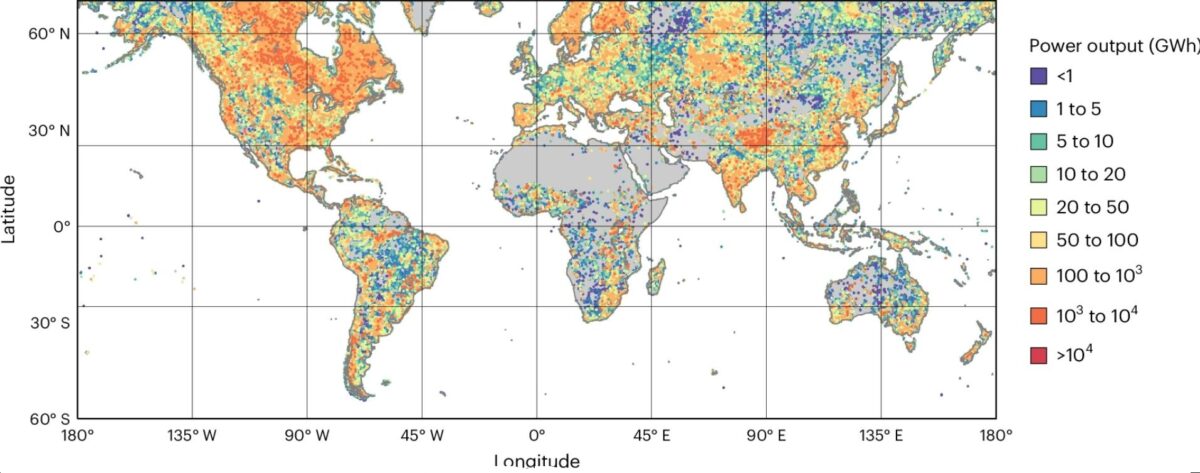From pv magazine Global
Some countries could meet their total electricity needs from floating solar panels, according to new research.
The research team, made up of researchers from Bangor and Lancaster Universities and the UK Centre for Ecology & Hydrology, calculated the daily electrical output of floating photovoltaics on nearly 68,000 lakes and reservoirs around the world, using available climate data for each location.
Their data included lakes and reservoirs where floating solar technology is most likely to be installed. All locations included were no more than 10 km from a population center, not in a protected area, didn’t dry up, and didn’t freeze for more than six months each year. The researchers calculated output based on a floating array covering 10% of the selected surface area, up to a maximum of 30 km2.
The potential annual electricity generation from floating photovoltaics across the 67,893 bodies of water was 1,302 TWh, equivalent to around four times the total annual electricity demand of the UK. The 1,302 TWh figure represents a conservative 10% surface area coverage, while the total theoretical potential was estimated at 14,906 TWh, which quantifies the energy generation potential of floating solar photovoltaics on over 1 million water bodies worldwide.
Although output across the analyzed areas fluctuated depending on altitude, latitude and season, five nations – Benin, Ethiopia, Kiribati, Rwanda and Papua New Guinea – were found to have the potential to meet their entire electricity needs from floating photovoltaics. Other countries could come close, such as Bolivia and Tonga, which could meet 87% and 92% of their electricity demand.
Many countries, mainly from Africa, the Caribbean, South America and Central Asia, could meet between 40% and 70% of their annual electricity demand through floating photovoltaics. The average across all countries was 16%. The highest-scoring European nations were Finland, at 17% of its electricity demand, as well as Sweden and Denmark, at 16%.
“Even with the criteria we set to create a realistic scenario for deployment of floating photovoltaics, there are benefits across the board, mainly in lower income countries with high levels of sunshine, but also in Northern European countries as well,” said lead author, Iestyn Woolway. “The criteria we chose were based on obvious exclusions, such as lakes in protected areas, but also on what might reduce the cost and risks of deployment.”
The researchers do warn that further research is needed on the overall environmental impact of floating solar. They suggest that decisions to deploy arrays should consider the intended function of water bodies and how they are used, as well as the potential ecological impact. “We still don’t know exactly how floating panels might affect the ecosystem within a natural lake, in different conditions and locations,” Woolway added. “But the potential gain in energy generation from floating photovoltaics is clear, so we need to put that research in place so this technology can be safely adopted.”
Their findings are available in the research paper “Decarbonization potential of floating solar photovoltaics on lakes worldwide,” published in nature water.
Last year, an international team of researchers assessed the potential of deploying floating solar across almost 115,000 reservoirs worldwide and found it may reach 9,400 TWh.
This content is protected by copyright and may not be reused. If you want to cooperate with us and would like to reuse some of our content, please contact: editors@pv-magazine.com.








By submitting this form you agree to pv magazine using your data for the purposes of publishing your comment.
Your personal data will only be disclosed or otherwise transmitted to third parties for the purposes of spam filtering or if this is necessary for technical maintenance of the website. Any other transfer to third parties will not take place unless this is justified on the basis of applicable data protection regulations or if pv magazine is legally obliged to do so.
You may revoke this consent at any time with effect for the future, in which case your personal data will be deleted immediately. Otherwise, your data will be deleted if pv magazine has processed your request or the purpose of data storage is fulfilled.
Further information on data privacy can be found in our Data Protection Policy.